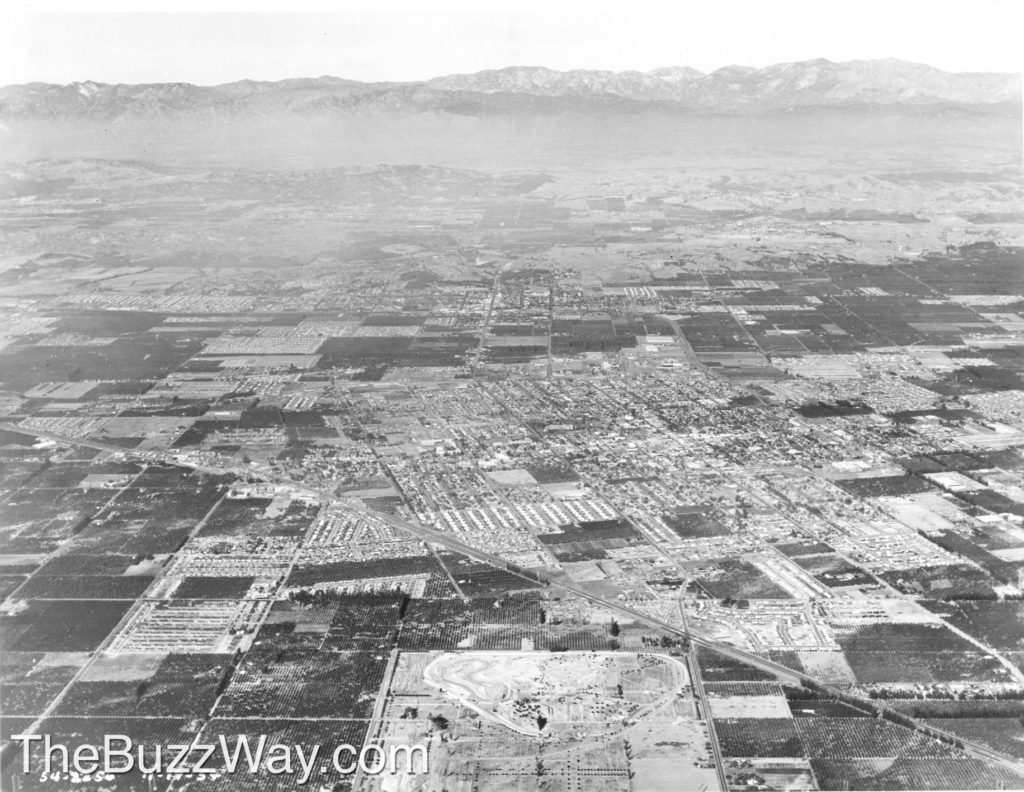THE OPENING OF DISNEYLAND SPARKED AN AMAZING EXPANSION OF THE REGION’S CREATIVE ECONOMY THAT CONTINUES TODAY!
I recently opened a lost box of some of my dad’s materials and discovered an amazing assortment of photos, notes and letters. Included were aerial photos of the land where Disneyland was to be located.

The photos capture the monthly progression of Disneyland’s construction in 1954; showing the concrete walls that define the portal entrances to the park, erected steel columns for structures lining Main Street, and extensive grading work forming the Park’s perimeter berm and future lands. The photos bring you back to a time when Orange Country was defined by extensive orange groves, the County’s array of small town centers and an unfolding pattern of development and growth all giving way to a transformation that was underway. The construction and opening of Disneyland represented an amazing emergence and expansion of the Region’s Creative Economy that continues today.

Creative Economy
Perhaps you are asking “What’s the Creative Economy? It’s driven by the arts, design and entertainment and today ranks 4th out of 66 clusters in LA County, representing one in eight jobs and generating $230 Billion in economic output annually. The strength of the Creative Economy in Southern California cannot be taken for granted going forward. The State of California is not educating a sufficient supply of workers for an economy that is shifting toward higher skill jobs and away from lower skill jobs. In addition, global competition for creative innovation and services is fast emerging.
Education
To maintain a leadership role in our Creative Economy and our Region’s future, we must invest in education. We have entered an age of idea making that emphasizes originality that cannot be easily outsourced, and that demands a creative and skilled workforce. More companies are seeking employees with creativity as well as problem solving and communications skills. Education is key to unlocking these critical skill sets vital to our Region’s future. Education provides competitive advantages that reach across almost every industry in the region.
The future of our Creative Economy demands a support system that sustains creative activity: industry sponsored internships and mentoring programs; similar outreach programs from trade associations like the Themed Entertainment Association, involving colleges and universities; and especially Nationally recognized arts education programs like Ryman Arts which is transforming the lives of talented high school students that will build careers in our Creative Economy.
Walt Disney recognized the importance of Arts Education when he conceived of a new multidisciplinary “community of the arts” school to nurture future generations of creative talent – “a place to develop the talent of the future” – and what he considered to be a “Living” legacy. Walt’s vision became CalArts located in Valencia, California. Buzz followed Walt’s lead by working steadfastly to launch CalArts, serving as the first President of the Board of Directors.
In another Art Education initiative, my parents Anne & Buzz, Marty & Leah Sklar, Sharon Disney Lund and Lucille Ryman Corrall launched Ryman Arts which prepares talented high school students with critical art skill sets and life skills important to developing future careers in the Creative Economy. You can visit RymanArts.org to learn more about Ryman Arts.
Summary
Thanks to Walt Disney and many others, Southern California has enjoyed a leadership role in creating a dynamic and expanding Creative Economy, but we now face competition from international markets that are understandably hungry and eager for a slice of our Region's Creative Economy. To continue maintaining a leadership role, we have to invest in education and NexGen Initiatives that prepare our young people. In a sense, part of the harvest from the expansive orange groves that covered much of Orange County requires added investment on multiple fronts: industry sponsored internships and mentoring programs; outreach programs from trade associations like the Themed Entertainment Association involving colleges and universities; and model programs like Ryman Arts which combine to build future Next Gen careers critical to sustaining and growing our Region’s Creative Economy.
